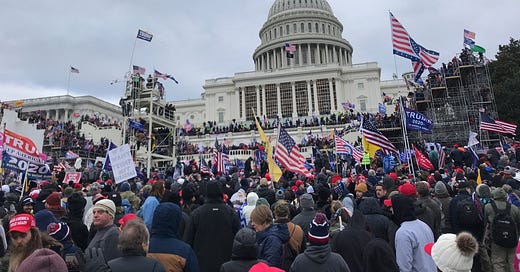Understanding Trump’s incitements to violence
Trump, the Inciter-in-Chief, has normalized political violence.
In the early hours of Saturday morning, a lone gunman allegedly impersonating a police officer killed Melissa Hortman, a prominent Democratic state representative in Minnesota, and her husband, Mark. In the minutes before that shooting, the gunman had allegedly already targeted another Democratic state senator, John Hoffman, and his wife, Yvette, who survived multiple gunshot wounds. The suspect, Vance Luther Boelter, was apprehended Sunday night.
I grew up about 10 miles from where Melissa Hortman was killed—and I met her during my previous career working in Minnesota campaign politics. She served for two decades in the Minnesota House of Representatives, including six years (2019-2025) as the speaker of the House.
During her time in public service, Hortman spearheaded efforts to expand paid family and medical leave, ensured new parents in poverty would get a refundable child credit, guaranteed free breakfast and lunch for Minnesota’s public-school kids, expanded protections for voting rights, and worked to put Minnesota on track for a much greener electricity supply by 2040. Those are her true legacies.
Hortman’s assassination will be remembered as a potent symbol of a broken country; of a frayed society tearing itself apart; of a failed politics based on division, hatred, and appeals to our basest instincts, all fueled by a president who peddles conspiracy theories, coddles zealots, and incites—even endorses—grotesque acts of political violence.
Though the suspect in her murder was once appointed by Democratic governors to serve on a comparatively minor state board, his target list makes clear that he sought to kill Democratic politicians and people affiliated with pro-choice causes. Moreover, his roommate has said that Boelter was a Trump voter who was struggling with mental health problems.
After I left Minnesota to get a PhD in Britain, I decided to try to understand broken societies that are torn apart by violence. For the past 14 years, I’ve studied the breakdown of democracy, the rise of authoritarianism, and the scourge of political violence—from Africa to the Middle East and from post-Soviet Europe to Southeast Asia. Sadly, those lessons have become tragically apt preparation for diagnosing the dysfunctional social toxins coursing through America’s veins.
The United States continues to lurch toward authoritarianism under Donald Trump—and his repeated incitements to violence have dangerously normalized the use of deadly force against politicians. He has created a political climate that makes it likely that assassinations will become a more frequent part of America’s news cycle—joining mass shootings as a depressingly common but unique phenomenon among peer countries.
When it comes to understanding political violence, the fool’s game is to try to work backward from a single assassination or attempted assassination to draw sweeping conclusions. In other words, it’s unwise to take one incident of political violence and then reverse-engineer what the cause was likely to be. That’s a mistake because acts of serious political violence—particularly assassinations—are rare events, often involving mentally unwell lone wolves. There’s therefore an element of randomness. Sometimes, a zealot or a mentally ill person just snaps, and there was no precursor, nobody to reasonably blame.
In a country with a population of 340 million people, there will always be some deranged potential ideologues—both on the political right and the political left—who could become killers. People who support Democrats and people who support Republicans might try to kill politicians. And in a country with more than 390 million guns in circulation, extremists have easy access to weapons of mass murder.
That’s why the right analogy to evaluate political violence is to consider the difference between weather and climate. If you evaluate one hurricane, it’s difficult to say, with certainty, that it was caused by climate change. But in a rapidly warming climate, we can say that climate change causes more frequent, more devastating hurricanes. The broader pattern and the drivers are clear, even if individual storms are harder to explain.
The same dynamics apply to political violence. We can rarely connect with certainty incitements to violence from political leaders with specific acts from lone wolves. Nobody knows exactly why those specific lawmakers were targeted. But what we can say is that leaders create political climates—and violent political climates produce more individual storms.
Trump, for the past decade, has been the Inciter-in-Chief. He called for “Second Amendment people” to deal with Hillary Clinton, his 2016 presidential rival. He specifically praised Greg Gianforte, now the governor of Montana, for having violently attacked a reporter. He called for shooting looters, shooting migrants, and shooting shoplifters. After a QAnon disciple tried to assassinate then House Speaker Nancy Pelosi but instead beat her husband, Paul, nearly to death with a hammer, Trump made light of the situation (while Trump’s son, Donald Jr., shared his “Paul Pelosi Halloween Costume” on Instagram, complete with a hammer for extra laughs).
Trump’s bogus conspiracy theories have further enflamed violence. Perpetrators act based on their beliefs. When the president spreads lies—about deep state plots, stolen elections, and secret cabals that run the government—some of the delusional dupes who believe him will take up arms to try to stop the fabricated fantasy.
Worst of all, when Trump’s words directly incite violence, he condones or celebrates it. After inciting the Jan, 6, 2021, attack on the U.S. Capitol, Trump started future campaign rallies with the National Anthem as sung by violent insurrectionists in prison, then pardoned them as one of his first acts back in the White House. After his tweet to “LIBERATE MICHIGAN!” during the pandemic resulted in armed protesters taking to the state capitol building and militia members later plotting to kidnap Michigan’s governor, Gretchen Whitmer, his reaction has been to float the idea of pardoning them, too. The message is chilling: If you try to destroy democracy by overturning an election or assault police officers or plot kill my opponents, there’s a chance I’ll protect you.
There is nothing remotely equivalent from Democratic leadership: no repeated incitements to violence, no pledges to protect criminals who target Republicans, no calls to shoot shoplifters or endorse candidates who attack journalists, and Kamala Harris, Hakeem Jeffries, and Chuck Schumer certainly didn’t post a photograph of a mocking Halloween costume on Instagram after Trump was nearly killed last summer.
The point is this: political violence cannot be fully eradicated in any society, but leaders can either act as arsonists, who spark the flames, or firefighters, who put them out. At every opportunity, Trump has played the arsonist. He has deliberately heated up a climate in which targeted violence has become part of the normal realm of politics. And, sadly, until Trump and the MAGA acolytes around him decide to stop showering the tinderbox nation with sparks, we should expect further assassinations and attempted assassinations in the years ahead.
@Brian Klaas is a professor of global politics at University College London. He writes The Garden of Forking Paths Substack newsletter and is a contributing writer for The Atlantic. His most recent book is FLUKE: Chance, Chaos, and Why Everything We Do Matters.







Many news reports on the Minnesota assassin describe him as a "devout christian." First of all, I am beginning to think that term is an oxymoron. Second, I will take any atheist over any so-called "christian." All the atheists I know are better people than any of the supposed christians I know.
Trump was not "nearly killed" last summer. Not even close. He supposedly suffered a wound to his ear -- a wound of which there has never been a visible trace in the time since. And the supposed shooter, whom the crack Secret Service team somehow managed not to discover while he was in place, was conveniently shot dead before he could say word one to anyone.
Prof. Klaas, you should know better.